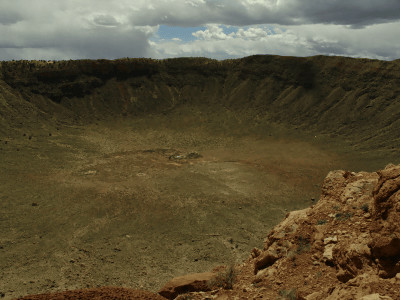An unknown huge crater is found under Greenland's glacier

Crater is a terrain characterized by a circular basin and an annular rise that surrounds it, made by collision of a meteorite and an asteroid. It is reported that such craters have been discovered from the glaciers of Greenland.
Huge, previously unknown impact crater found beneath Greenland's ice | Ars Technica
https://arstechnica.com/science/2018/11/huge-previously-unknown-impact-crater-found-beneath-greenlands-ice/
It is reported that the unknown crater was discovered this time is under the Hiawatha glacier in Greenland. People studying ice sheets spreading in Greenland are investigating the surface of the ice sheet, the layered structure of ice and the shape of the surface hidden beneath glaciers with a radar observation device mounted on the aircraft. Researchers who were analyzing images of such aircraft radar found that the topography under the glacier depicts a magical circle.
A research team at the University of Copenhagen in Denmark conducted further research and found that this circular topography was not a coincidental formation but a crater due to a meteorite collision. It is the evidence that the central part and the outer edge have a slightly raised part also as a crater due to a collision of the heavenly bodies. The diameter of the crater is about 31 km.
Craters can not be observed by digging directly through holes with a thickness of 900 m, but the research team focused on sediments at the bottom of the glacier flowing out from the edge of the glacier. A part of the sediment accumulated on the bottom of the crater was brought back and analyzed and found to be formed when a meteorite crash such as a piece of quartz having a pattern peculiar to a strong impact or a glass that solidified by melting and instantaneously A characteristic trace to be found was found. In addition, substances contained in iron meteorites such as iron and nickel were also discovered in comparison with the surrounding ground. According to the research team, the size of the colliding meteorite seems to have been about 1.5 km in diameter.

As the existence of craters can be confirmed, the question "When was this crater possible?" Will emerge. According to researchers, there are grooves that seemed to be rivers up to 2.6 million years ago on the ground around the craters, but that the grooves are broken in the range of craters.
On the ice on the crater, ice that has been produced during the period of the " Younger and Darius period " called the Ice Age , which occurred about 11,200 years ago in Europe, has accumulated. Based on these evidences, researchers estimate the collision time of the meteorite from about 2.6 million years ago to about 12,000 years ago.

Craters discovered this time are said to be ranked in the top 25 among the craters found on the earth so far and have been said to have had a great impact on the environment of the earth. Many researchers have thought that "The melting water leaked out of Canada's glacier and the heat circulation stopped" in the cause of the occurrence of the cold in the Younger Dryias. Among the researchers, "a collision of meteorites There were people who view that cooling has occurred due to " Craters newly discovered for the latter group may be important evidence.
Unfortunately for now it has not been found a strong connection between the craters and the Younger Dorias period and can not be used to corroborate the theory that crater is the cause of the cold weather immediately as a collision of the meteorite. Researchers think that they will not jump to conclusions easily and that further research will be necessary in the future.
Related Posts:
in Science, Posted by log1h_ik







